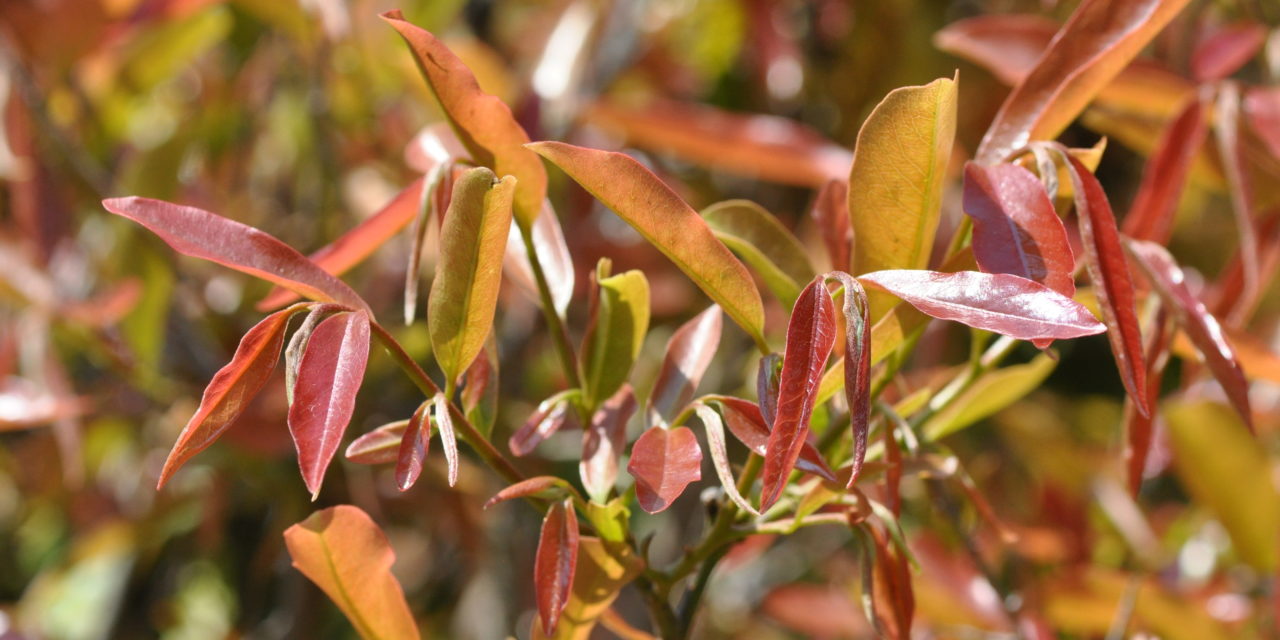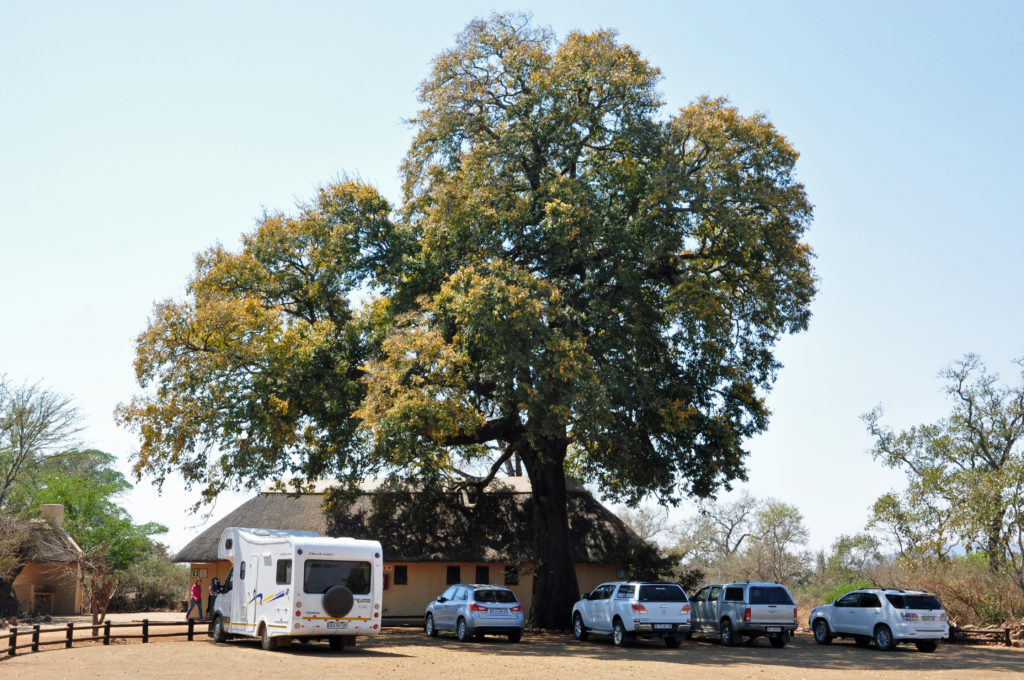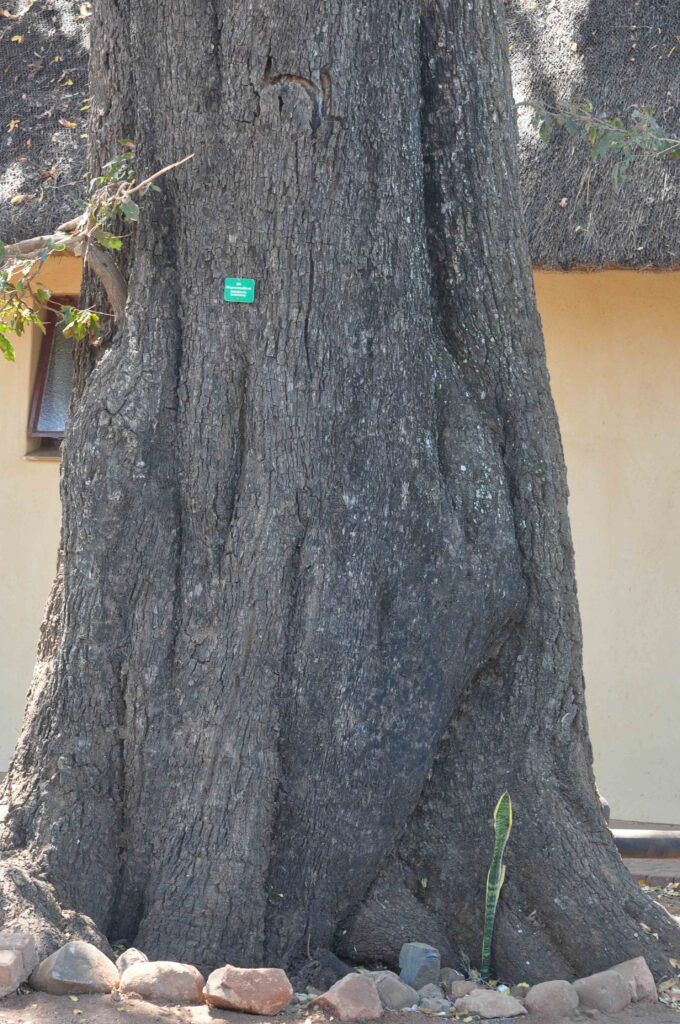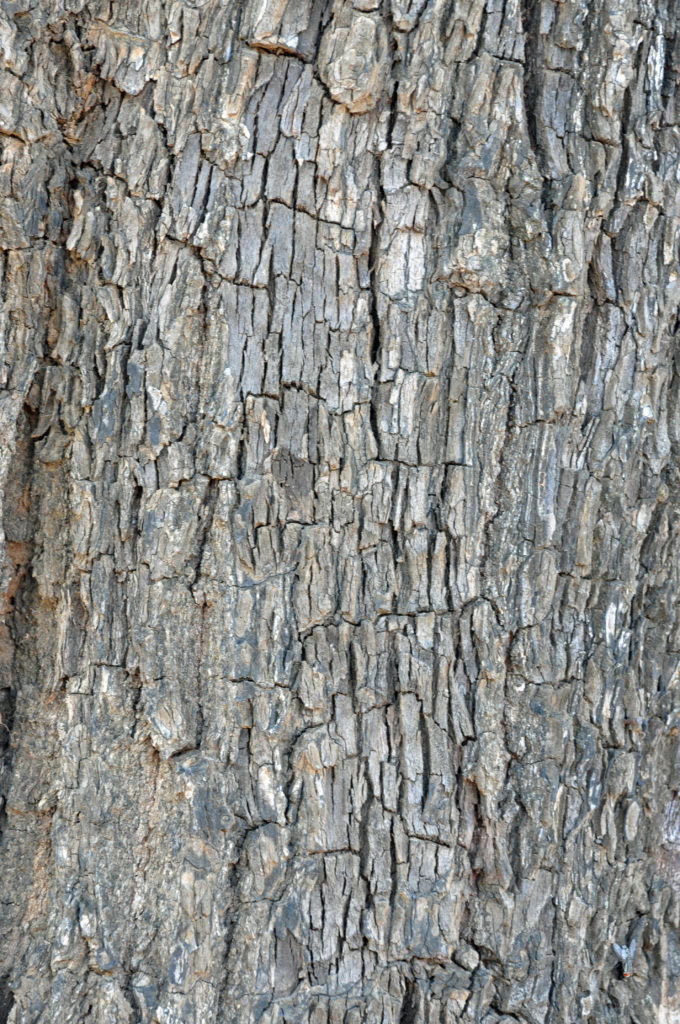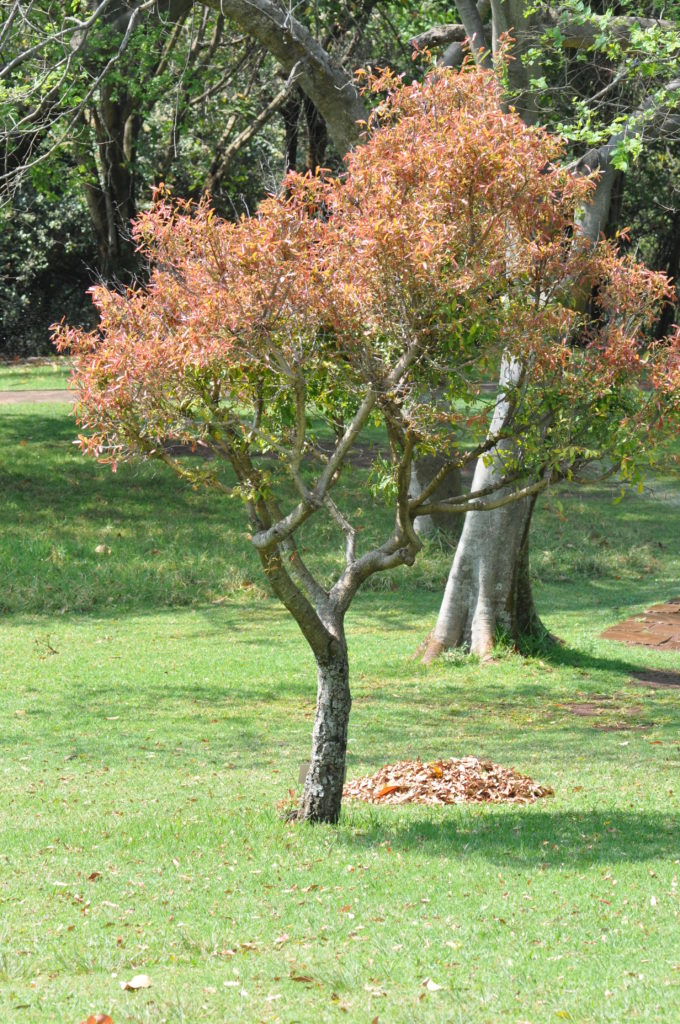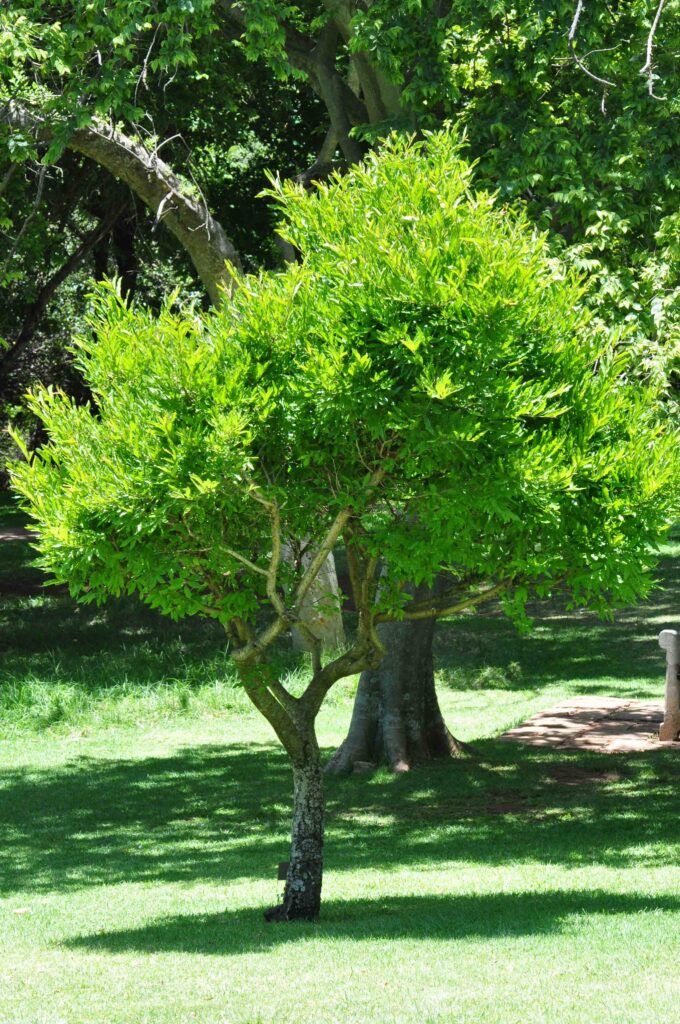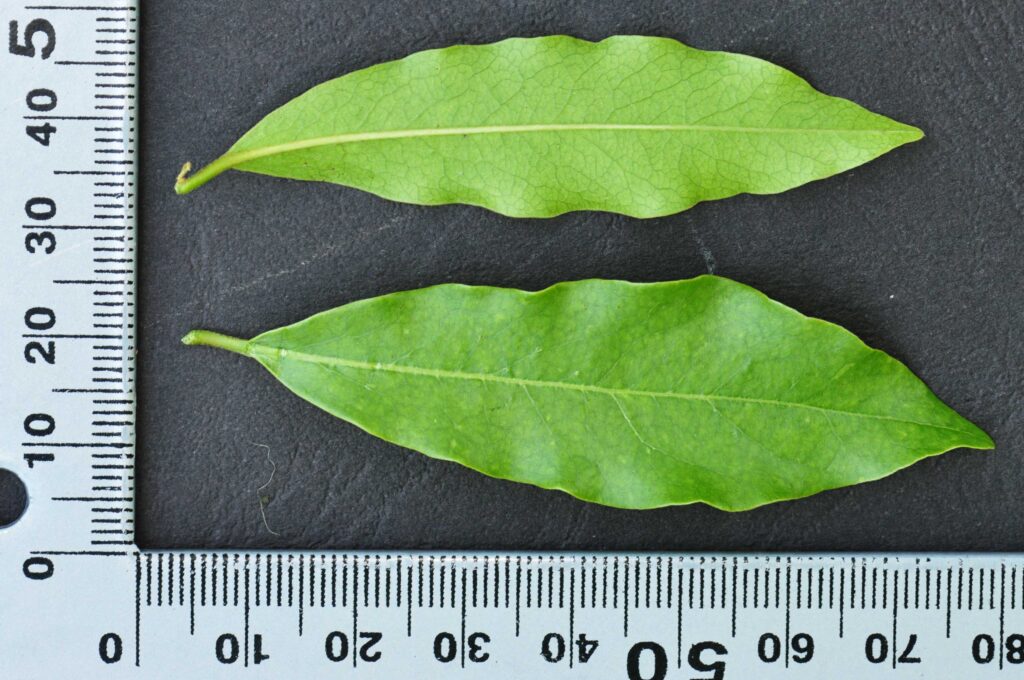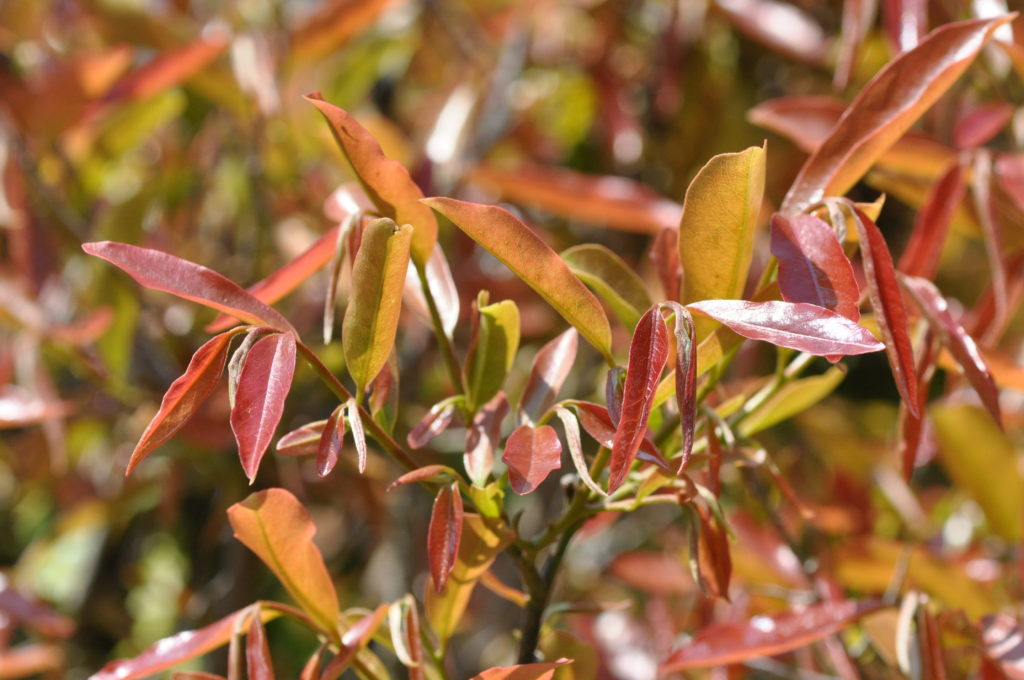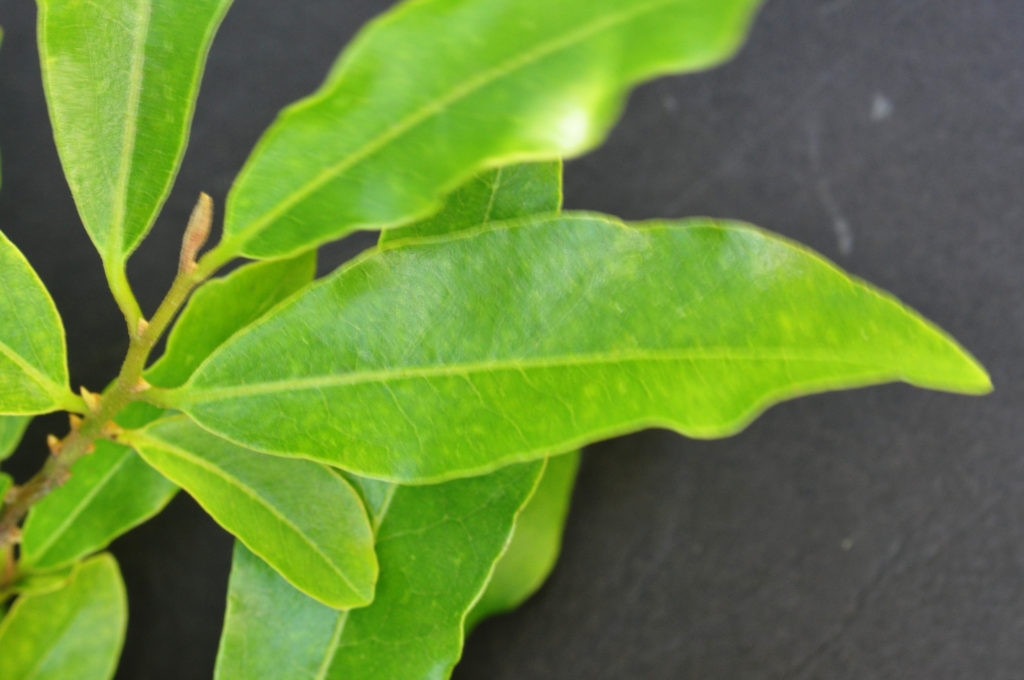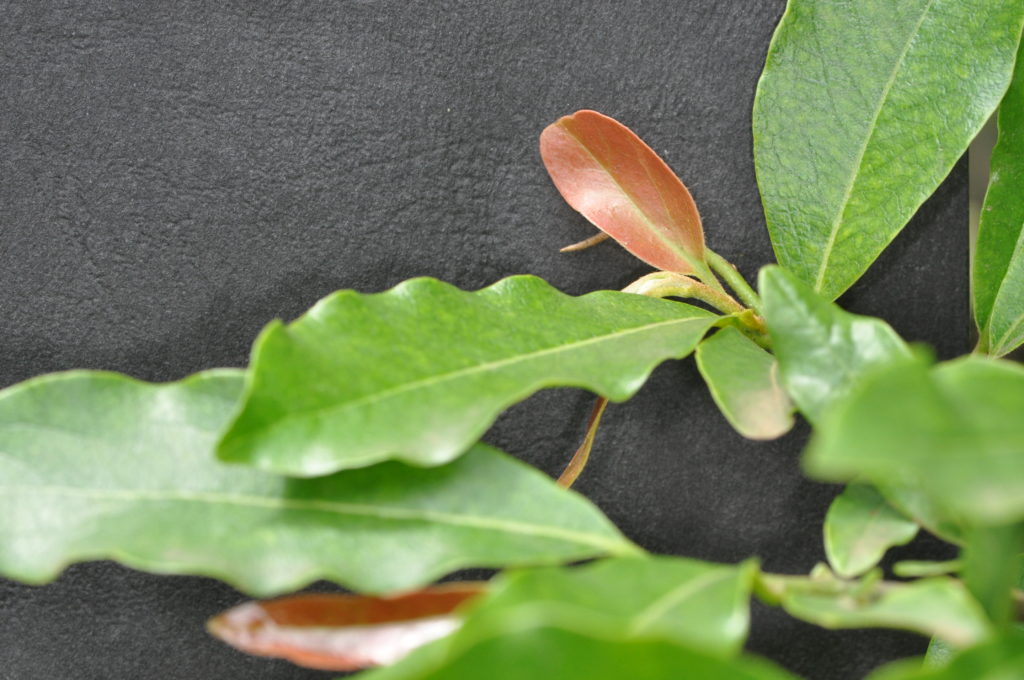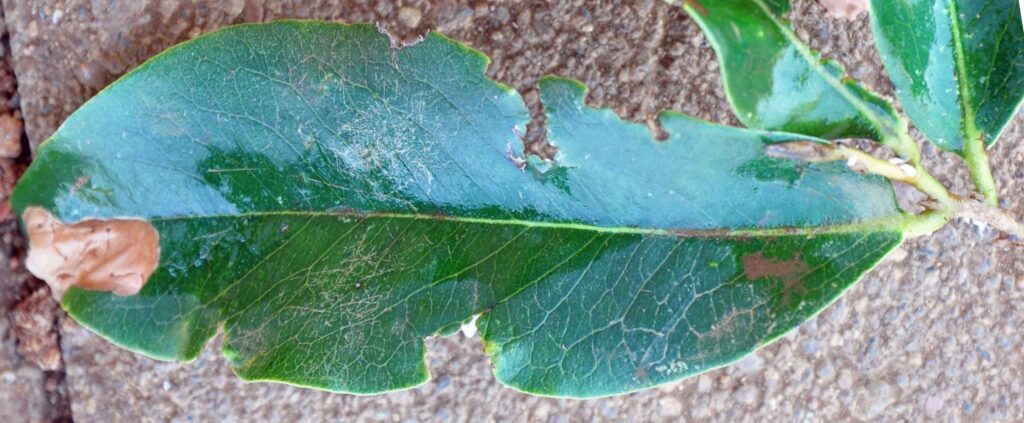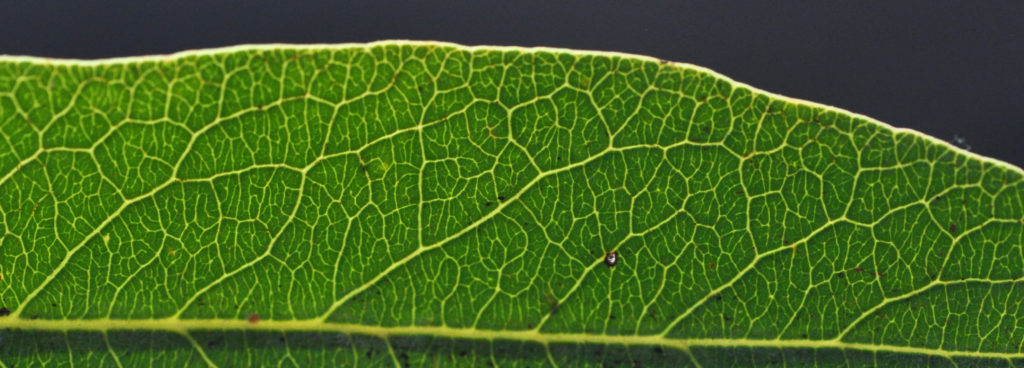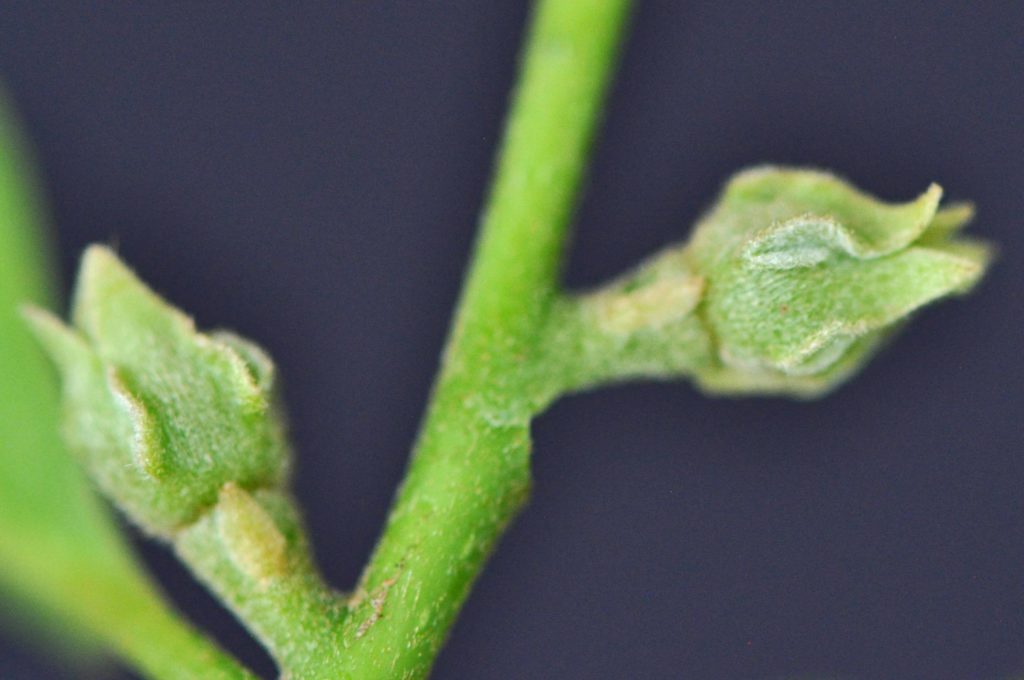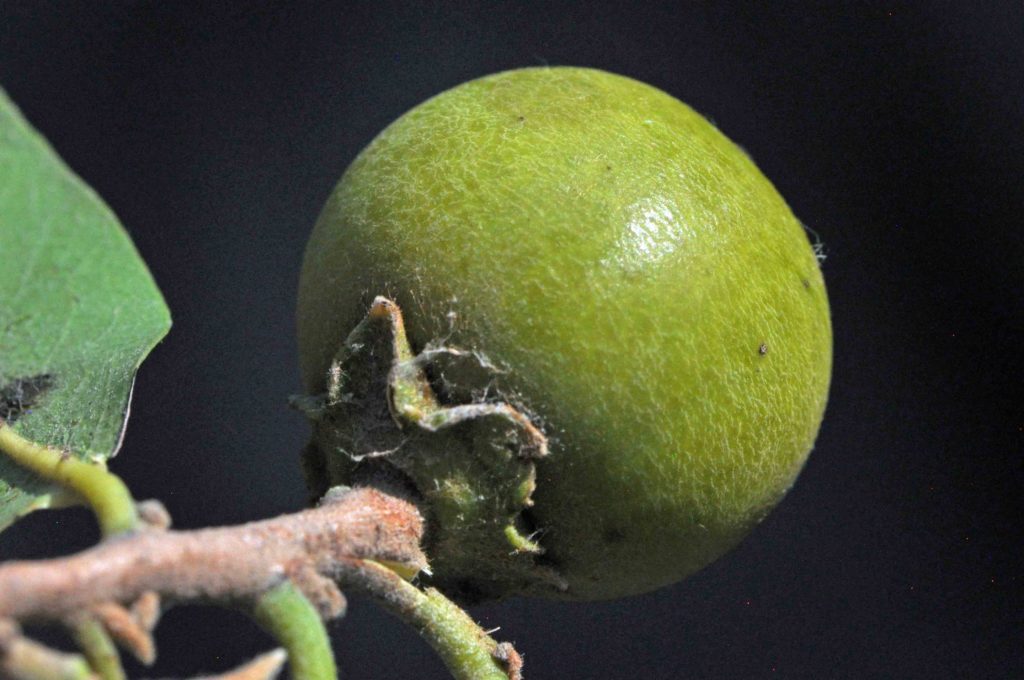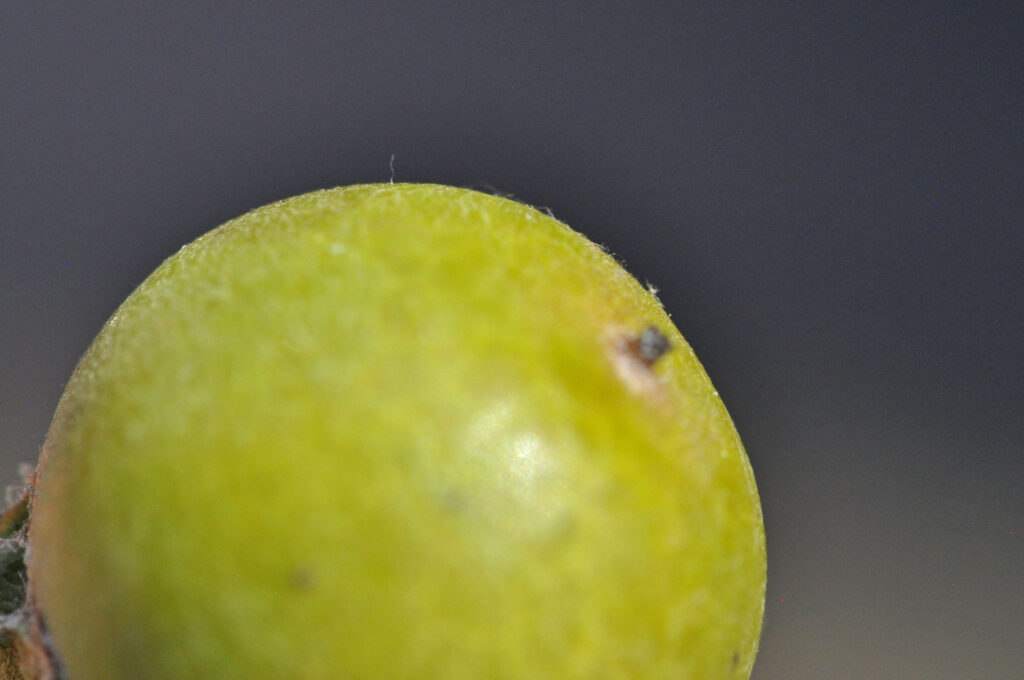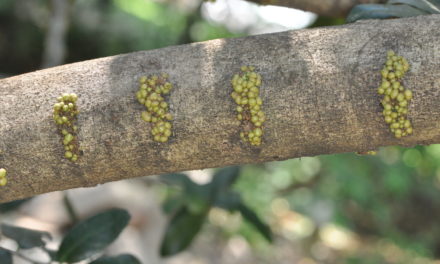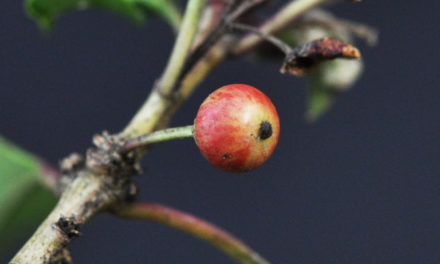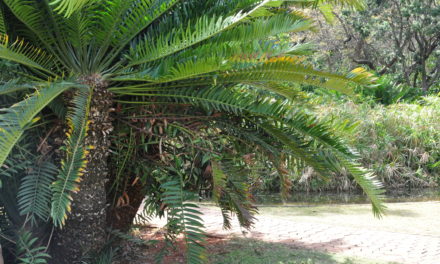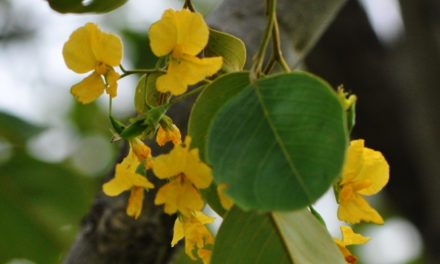Diospyros mespiliformis
General Info – summary
This impressive, ecologically important, dioecious Tree with its branched crown is without milky sap & is up t0 20m high, or it may be a shrub. Longitudinal fissured bark is dark. Initially reddish, simple & entire Leaves have short petioles and lack stipules. Small white/yellowish, 4 or 5-merous, regular Flowers have an accrescent calyx. A pedicel is only absent in male flowers. Fruit: a solitary berry with red/brown seeds.
Description
Previous Names: Diospyros bicolor, Diospyros holzii, Diospyros senegalensis, Diospyros sabiensis.
SA Tree No. 606.
Common names: (Afr) Ebbenhout, Jakkalsbessie, Mierhout, Transvaalebbehout. (Eng) African Ebony, Bush Matome, Ebony, Hill Matome, Jackal-berry, Monkey Guava, Rhodesian Ebony, Transvaal Ebony. (isiZulu) Umtoma. (Northern Sotho) Dithetlwa, Motlouma, Umdhlausu, Umdlawuzo. (siSwati) Umtoma, Umtomo. (Tshivenda) Musuma. (Xitsonga) Mgula, Ntoma.
Family: Ebenaceae persimmon and ebony family). The family has some plants known for their useful wood and others for fruit. Trees are usually located in tropical and warmer temperate regions. There are more than 750 species, in 4 genera, worldwide and the 37 species in South Africa occur in 2 genera (Euclea and Diospyros). The bark and heartwood are black. The simple, coriaceous and entire Leaves lack stipules and are usually alternate or may be opposite, but both may occur on the same plant. The usually unisexual and regular Flowers have a persistent calyx that is often divided near to the base. The corolla usually has a short tube, with Petals fused at the base and extending into overlapping lobes. The basifixed anthers are longer than the filaments. The superior ovary has up to 2 ovules in each locule. The styles may have 2-5 branches. Fruit is a berry with an accrescent calyx, which may dehisce slowly. Young fruit contains tannins and is usually avoided by animals until ripe.
Name derivation: Diospyros (Dios – divine; pyros – pear – referring to the flavour of some fruits). mespiliformis – like Mespilus germanica (the common medlar) fruit in the Rose family – found in SW Asia. Another possibility: mespiliformis “half bullet” referring to the shape of the fruit. Either may be valid.
Worldwide there are more than 700 species in the genus Diospyros. These species are tropical and subtropical and usually dioecious (unisexual floral structures with male and female parts are on separate plants). In southern Africa, there are about 20 species in the genus. The valued timber trees are called Ebony trees. These produce dense, hard and dark timber. Trees valued for their fruit are known as persimmon trees and none of these is indigenous. Diospyros plants are tropical (most) or subtropical, usually dioecious (unisexual floral structures with male and female parts are on separate plants).
Conservation: National Status: L C. (Least Concern). Assessors: Raimondo et al. (2009).
Tree
The single, upright Stem (main axis of the plant, the leaf and flower bearing as distinguished from the root-bearing axis), branches high up (photo 504). No milky sap is present in this medium to tall Tree that may reach 25m high and occasionally grows as a shrub in dry areas. This is the biggest tree of this genus and has a dense, much-branched Crown (photo 504). The Trunk has a diameter of up to 1,5m and the base is buttressed (buttress – the broadened base of a tree trunk – photo 497). Twigs (1-year-old current branch segments) initially have reddish hairs, that become smooth and hairless. High branch ends tend to droop. Their growing tips and young leaves (photo 626) are pinkish. Bark is blackish dark grey and rough with deep longitudinal fissures (photos 497 & 498). The inner bark is reddish. This tree may survive for at least 150 years.
- 504. 2014/09/10. Tshokwane KNP. Photo: David Becking.
- 497. 2014/09/10. Tshokwane KNP. Photo: David Becking.
- 498. 2014/09/10. Tshokwane KNP. Photo: David Becking.
- 626. 2015/09/22. Walter Sisulu NBG. Photo: David Becking.
- 51. 2105/11/24. Walter Sisulu NBG. Photo: David Becking.
Leaves
The alternate (photo 06) and usually oblong to elliptic Leaves are distichous (arranged in two vertical rows on opposite sides of the stem (photo 6). The leaves tend to occur towards the ends of branches and often remain on the tree until the new leaves form (photo 499). The usually evergreen (new spring leaves emerge before old leaves fall) tree has leaves that are long, narrow and up to 14 x 4,5cm (photo 08). They are simple (have a single blade, which may have incisions that are not deep enough to divide the blade into leaflets). The thin, translucent, pubescent (hairy) new leaves are an attractive bright reddish colour – especially in young plants (photos 627 here & 626 under Tree). The blade of mature leaves is thickish, leathery and glossy dark green above (photo 499). They may be slightly lighter green below and here they may be smooth or with silky hairs. Leaves may turn yellow in autumn. The delicate Veins are slightly more obvious below, where the clearly visible midrib protrudes. The delicate vein pattern is best seen when a youngish leaf is viewed against a strong light (photo 78). This photo shows that the lateral veins tend to loop before reaching the margin. The Apex is pointed (photo 08) or rounded. The Base is rounded, narrowed or tapering and may be asymmetric (not equal to the opposite side). Some silky hairs may be present. The often-wavy Margin (photo 912) is entire (with a continuous margin, not in any way indented). The short Petiole (leaf stalk) is up to 8mm long (photo 08) and lacks Stipules (basal appendages of the petiole).
- 08. 2014/11/25. Walter Sisulu NBG. Photo: David Becking.
- 627. 2015/09/22. Walter Sisulu NBG. Photo: David Becking.
- 06. 2014/11/25. Walter Sisulu NBG. Photo: David Becking.
- 912. 2015/01/20. Walter Sisulu NBG. Photo: David Becking.
- 499. 2014/09/10. Tshokwane KNP. Photo: David Becking.
- 78. 2019/08/12. Skukuza KNP. Photo: David Becking.
Flowers
The tree is dioecious (unisexual floral structures with male and female parts on separate plants). The cream to pale yellow, 4 or 5-merous, narrowly bell-shaped and fragrant Flowers develop in leaf axils. Flowers are actinomorphic (Regular, symmetrical. Flowers are vertically divisible into similar halves by more than 1 plane passing through the axis). Each flower is up to 1,2cm long. The creamy grey hairy Calyx is attached to the corolla and has short, crisped lobes that curl backwards. These lobes are persistent and accrescent (increasing in size with age). The whitish, urn-shaped and externally hairy Corolla has united Petals and appears as a single piece. The short lobes become recurved (photo 384). The 3+, sessile Male flowers are in small, stalked bunches in leaf axils and only have a rudimentary Ovary. Each usually solitary Female flower develop in a leaf axil and rests on a short Pedicel (stalk of a single flower – photo 384). Creamy grey hairs are present on both the outside of the calyx and on the pedicel (photo 384). Here a single Pistil (a unit of the Gynoecium, the female element of the flower, composed of the Ovary, Style and Stigma) rests on a hairless somewhat fleshy Disc (a more or less fleshy or elevated development of the receptacle). The Ovary is superior. Pollinators are mainly insects, including bees. (Oct-Jan).
- 384. 2019/10/22. Walter Sisulu NBG Photo: David Becking.
Fruit
The ovoid to almost spherical Fruit is a solitary, fleshy Berry (pulpy, indehiscent fruit like a grape or tomato). This berry is up to 2,5cm in diameter and has a conspicuous fairly deeply lobed accrescent (continues to grow after flowering) Calyx with recurved triangular lobes, which initially reaches about a third of the way up the fruit but dries and partly breaks down as the fruit matures (photo 79). The fruit terminates with a persistent bristle like tip. Short, soft hairs are present only when young. The green berry becomes yellowish or purplish when ripe. The surface usually remains smooth, but it may become slightly wrinkled. It has a tough skin covering the fleshy layer. At maturity, the fruit surface may be slightly wrinkled. The dry mature fruit dehisces, releasing between 3 and 6 smooth, flattish Seeds, each up to 1,3cm long. Seeds are reddish brown, mottled and flattish with a visible groove that is nearly straight. (Mar-Oct).
- 79. 2019/08/12 Skukuza KNP Photo: David Becking.
- 80. 2019/08/12. Skukuza KNP. Photo: David Becking.
Distribution & Ecology
This frost sensitive Tree grows in woodland bush and seldom grows above an altitude of 2 000m. It is widespread in tropical Africa – mainly close to riverbanks and is common within termite mounds in low-lying areas. The termite mounds provide both air and water for the tree and termites feed on the roots – a mutualistic relationship. Elephant, eland, kudu and the larvae from the Bushveld Emperor butterfly Charaxes achaemenes achaemenes feed on the Leaves and on the leaves of Piliostigma thonningii and Pterocarpus sp. The Fruit attracts large numbers of birds including Grey Hornbills, African Green Pigeons, Brown-headed parrots and Purple-crested turaco (lourie). Monkeys, baboons (which both help with seeds dispersal), jackals and kudu also feed on the fruit. From this point of view, this is significant and emphasises the ecological importance of this plant. In South Africa this tree occurs in Limpopo and Mpumalanga: an excellent specimen is visible at Tshokwane in the Kruger National Park (photo 494). These trees also occur in Swaziland, Mozambique (widespread), Zimbabwe, Northern Botswana, and Northern Namibia including Caprivi Strip, Senegal and from Ethiopia to Yemen.
Ethnobotany
Recently cut Wood is pink but dries to be almost black and resembled ebony. It is close grained, and has reddish to dark heartwood that is reasonably resistant to termites. It is heavy, hard and difficult to work. The wood is used to make planks, dugout canoes, flooring, carvings, household utensils and furniture. In days gone by, felloes (the outer rim of a wagon wheel to which the spokes were fixed) were made from it. The bar at Leydsdorp (a former gold rush town) – about 11km from Gravelotte in Limpopo was made using this wood). Dugout canoes used in the Okavango Swamps, firewood and charcoal manufacture are other uses made of this wood. In Gambia, the tree is classified as an important timber species. Livestock consume fallen Fruit. Bark and leaves contain tannin. The lemon-like Fruit is edible either fresh or dried and may be kept as a food reserve. It is used to make beer and brandy. Ground fruit is used to make porridge. The edible Seeds have a nut-like taste and can be eaten raw or stored for future use. This is a slow growing, important feeder tree. In order to produce fruit, cuttings should be taken from separate male and female plants. The plant is also used for re-afforestation and windbreaks. It provides excellent shade. Root, bark and leaf extracts have shown antimicrobial activities against bacteria and fungi supporting the traditional use of the tree as medication. Some believe the tree has magic properties.
References
Boon, R. 2010. Pooley’s Trees of Eastern South Africa. Flora and Fauna Publications Trust, Durban.
Burrows, J.E., Burrows, S.M., Lotter, M.C. & Schmidt, E. 2018. Trees and Shrubs Mozambique. Publishing Print Matters (Pty) Ltd. Noordhoek, Cape Town.
Coates Palgrave, M. 2002. Keith Coates Palgrave Trees of Southern Africa. edn 3. Struik, Cape Town.
Foden, W. & Potter, L. 2005. Diospyros mespiliformis Hochst. ex A.DC. National Assessment: Red List of South African Plants version . Accessed on 2024/12/20.
Ginn, P.J. McIlleron, W.G. Milstein, S. 1989. The Complete Book of Southern African Birds. Struik Publishers (PTY) LTD. Third impression 1991.
Lawrence, G. H. M, 1951. Taxonomy of Vascular Plants. The Macmillan Company, New York. Tenth Printing 1965.
Palmer, E. & Pitman, N. 1972. Trees of southern Africa. Balkema, Amsterdam, Cape Town.
Schmidt, S. Lotter, M. & McCleland, W. 2002. Trees and Shrubs of Mpumalanga and the Kruger National Park.
van Wyk, B. & van Wyk, P. 1997 Field guide to Trees of Southern Africa. Struik, Cape Town.
http://www.plantzafrica.com/plantcd/diospyrosmespil.htm
http://www.fao.org/docrep/X5327e/x5327e0z.htm
http://worldagroforestry.org/treedb2/AFTPDFS/Diospyros_mespiliformis.PDF
http://www.zimbabweflora.co.zw/speciesdata/species.php?species_id=144030
http://www.prota4u.org/protav8.asp?p=Diospyros+mespiliformis
http://posa.sanbi.org/flora/browse.php?src=SP

